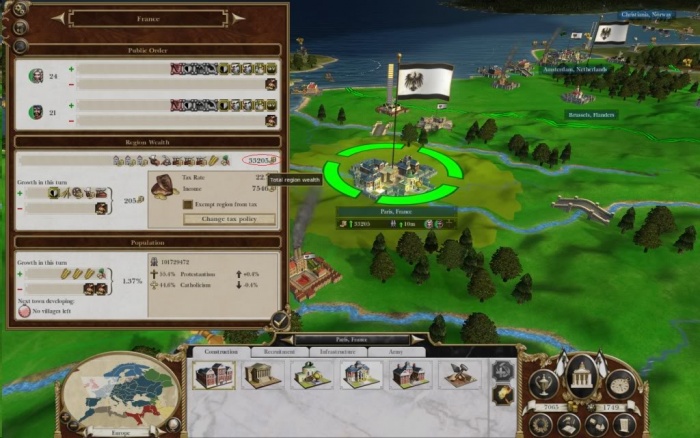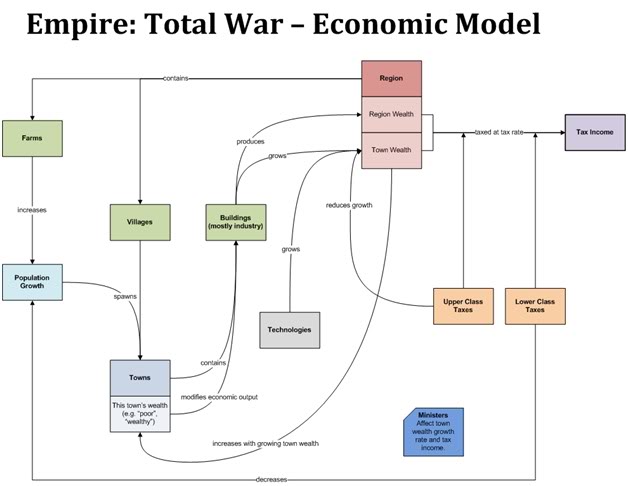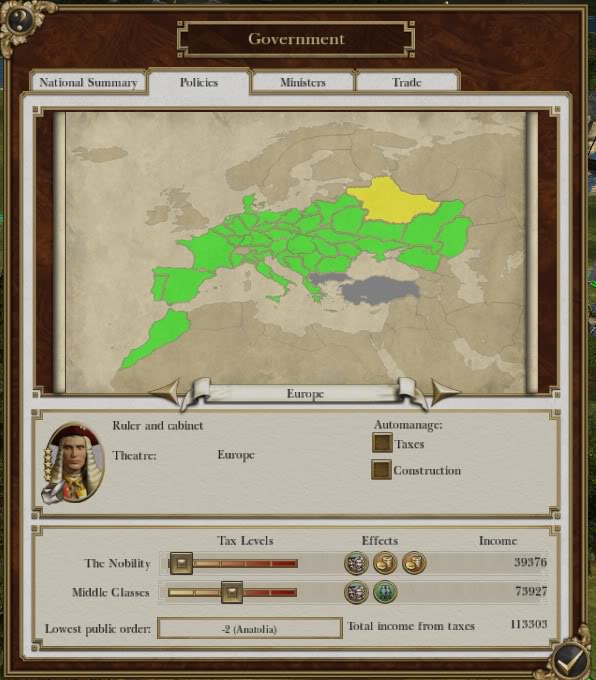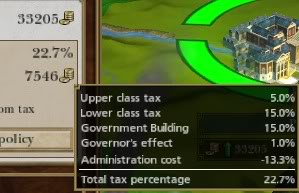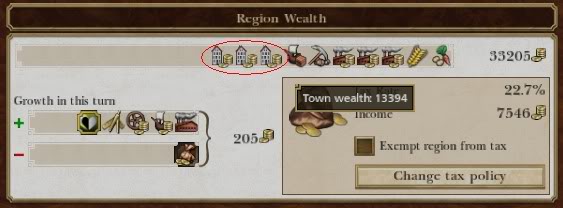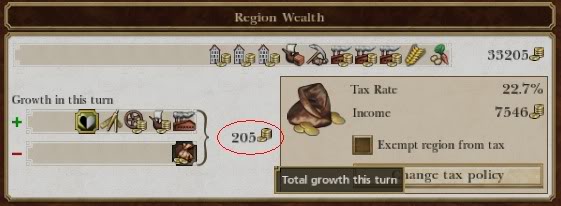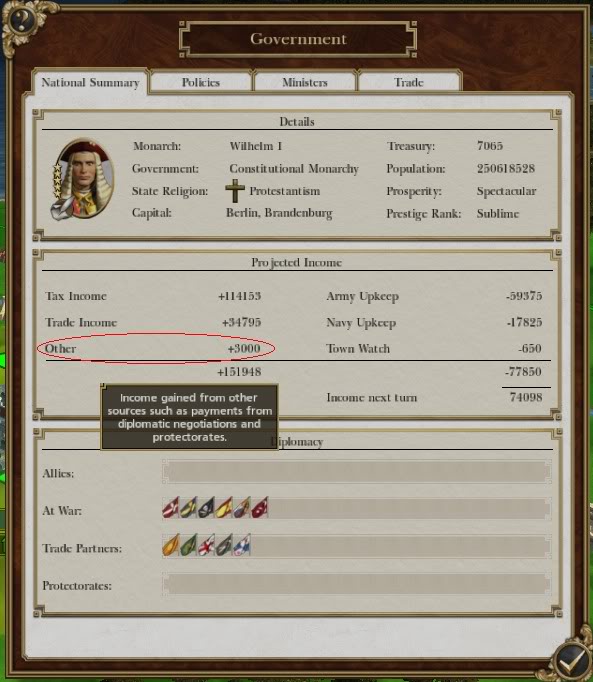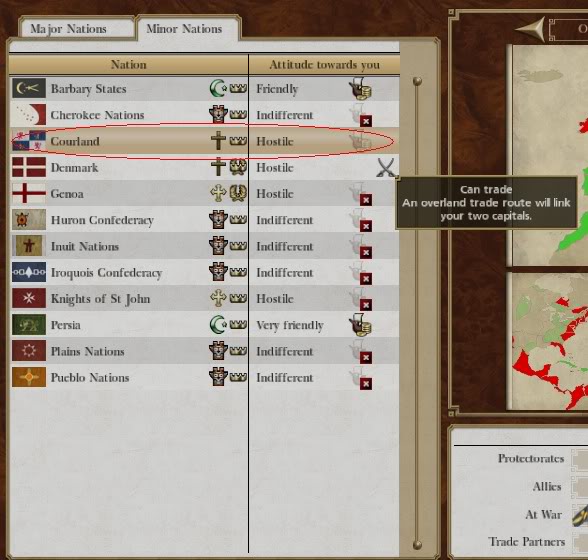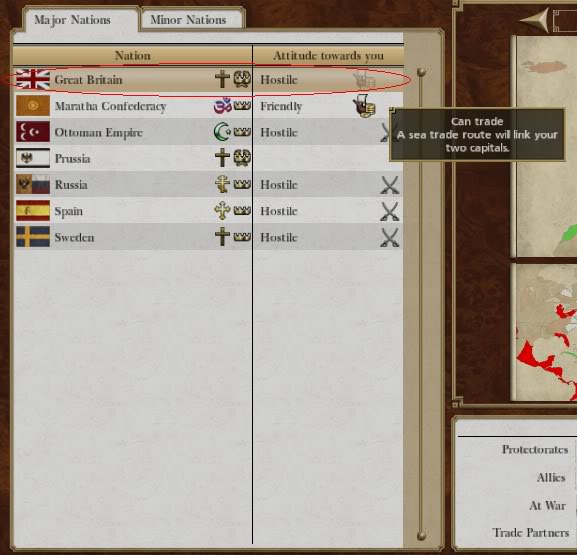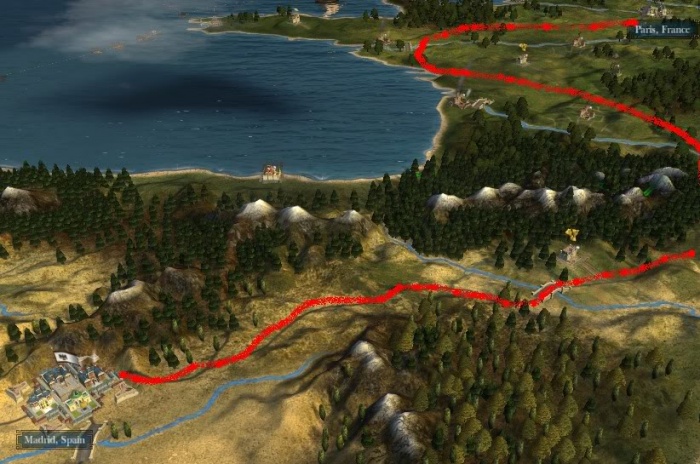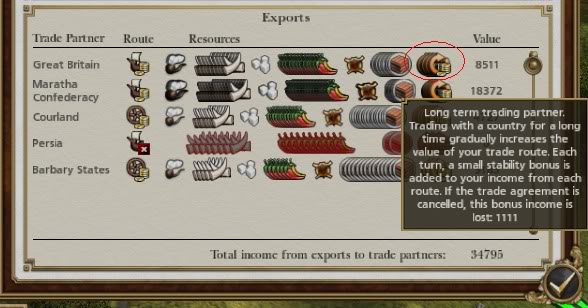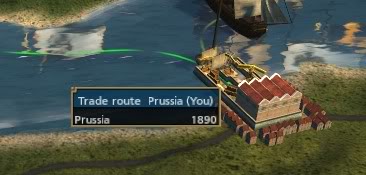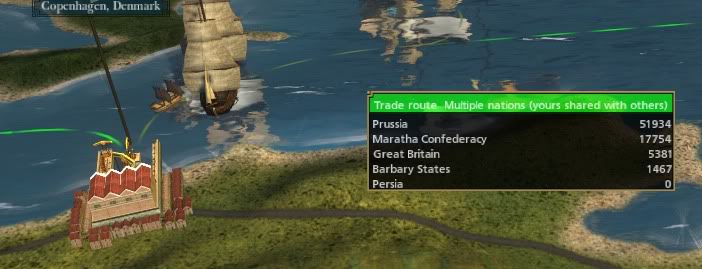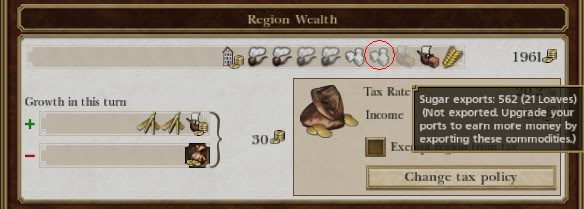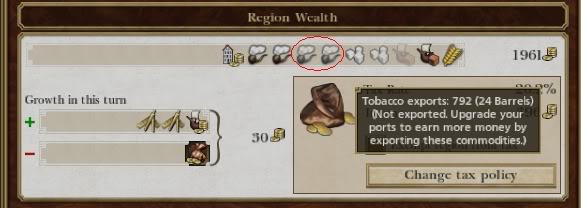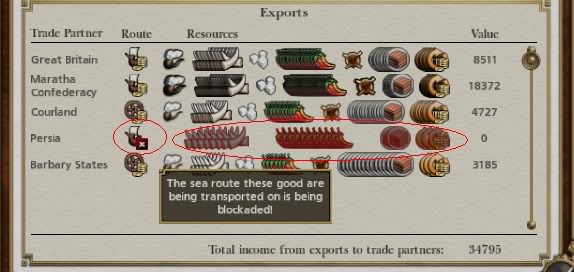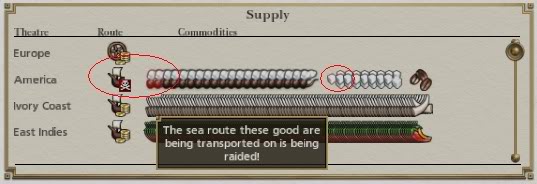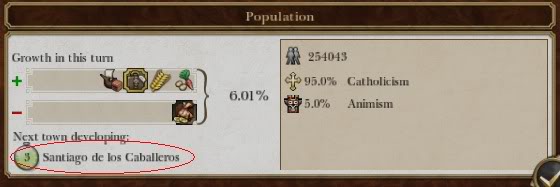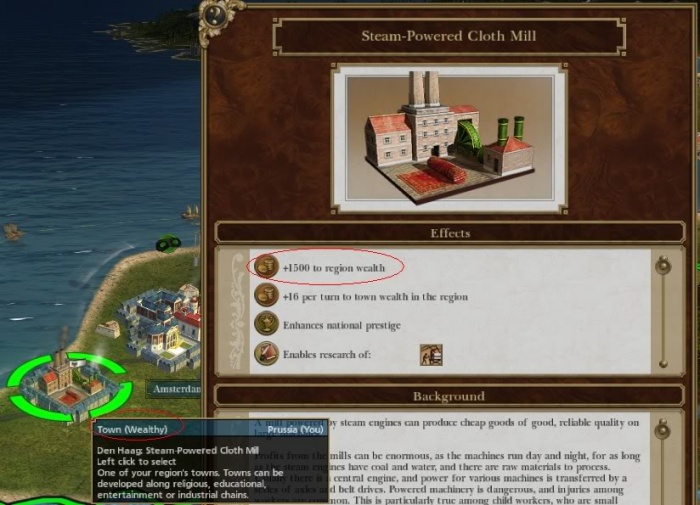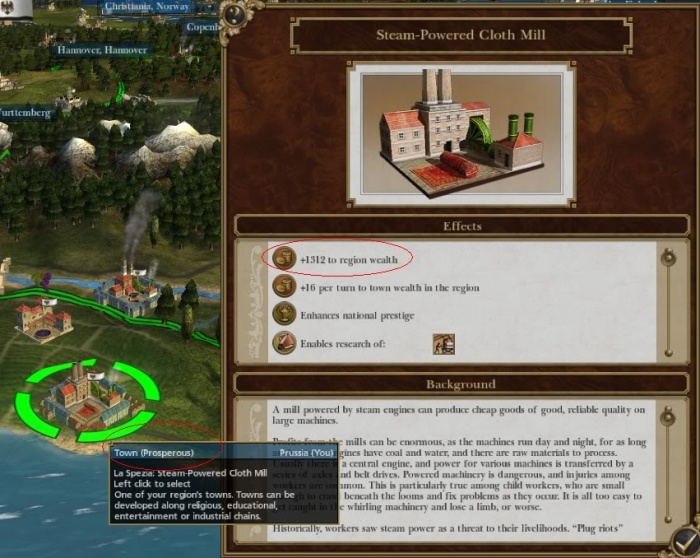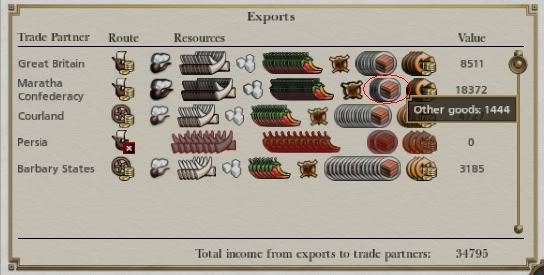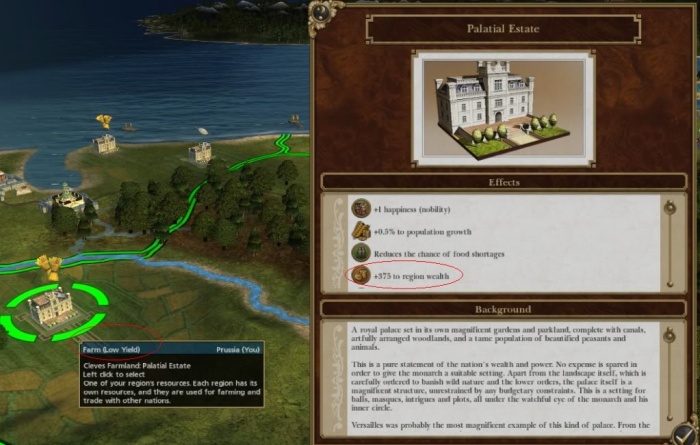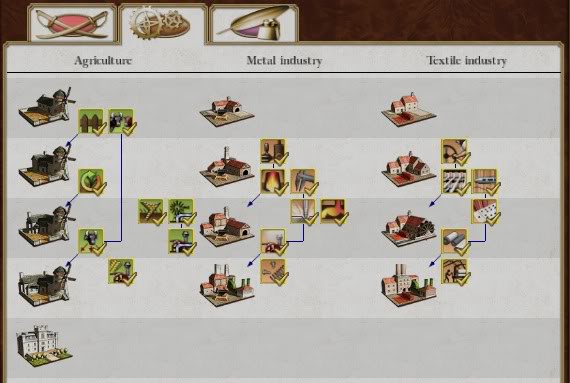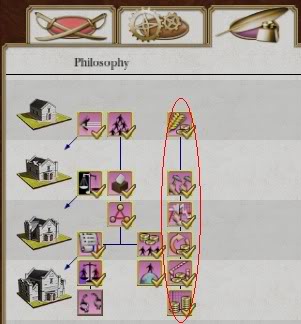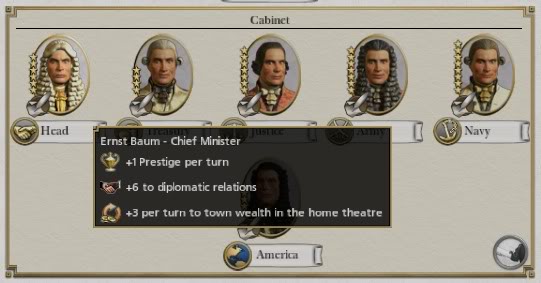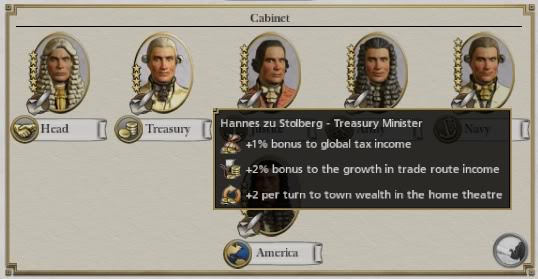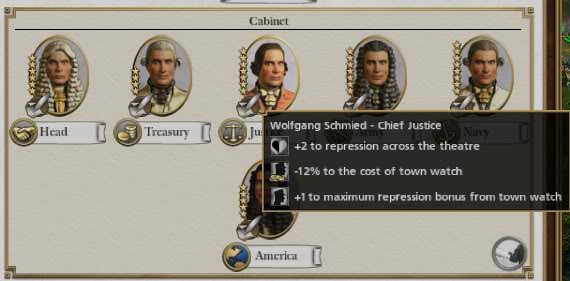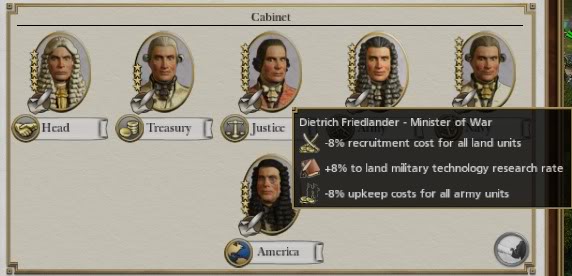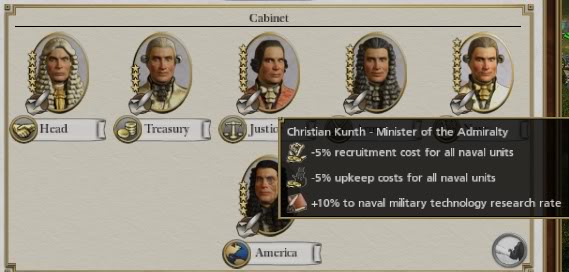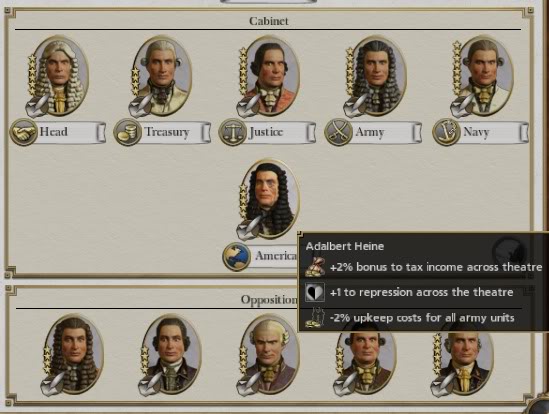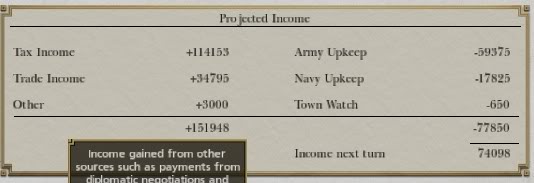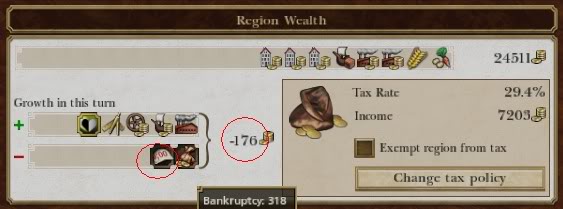DarkSideHome's Economy Guide to Empire: Total War (ETW community guide)
Author: DarkSideHome
"An army marches on its stomach" Napoleon Bonaparte
You get this quote from time to time on the loading screen of E:TW, and it pretty much sums the philosophy of E:TW. The Total War series has always been about battles and building up empires. However, to recruit armies and maintain your empire you need money.
Title after title, the sophistication of the economical system kept evolving and each installment required more micromanagement and offered more options for the player to customize one's empire.
Income sources in E:TW are comprised of Taxes, Trade, King's Purse, Protectorate tribute, from treaties with other nations and raiding. This income will be spent to develop your empire, recruit new armies and fleets, maintaining your troops and keeping your population under control.
Region Income
In Empire: Total War we saw the introduction of regions with towns outside the city for the first time in a Total War game. Each region has a capital, and whatever nation controls the capital will control the region and benefit from its income. Outside the capital you have towns, farms, mines, plantations, ports and road infrastructure. The level of each of these structures will affect how much money it will contribute.
Taxation
"But in this world nothing is sure but death and taxes" Benjamin Franklin
I'll deal with the later part of Mr. Franklin wise quote, and leave the first part to your battle prowess. Taxes is one of your two major sources of income, the other being trade. The following graph that was posted by Thamis of the Creative Assembly explains in a nutshell how taxation and wealth interact with each other
Each region has a certain income as explained earlier, but in the game you don't get the whole income generated by your regions. In reality, what you get is a percentage of this income in the form of taxes.
Taxes in E:TW are controlled through Theater Policies that you manage in your policies tab. That means you can have three separate tax policies, one for each of the theaters: Europe, Americas and India.
For finer micromanagement, you even get separate tax policies for each class in your empire. For the scope of this guide, I will refer to the classes as either higher classes or lower classes.
You can even exempt regions from paying taxes at all, as this will encourage wealth and population growth, while removing any unhappiness that results from taxation.
While you are setting your tax policy, you will notice that you have two bars of five slots for the two taxable classes. Each slot in these bars represents a different taxation level. The first slot will give you 5% increase to the tax rate in the region from the selected class, and each extra slot will give you an extra 5%, for a max of 25% for the fifth slot.
For example, if you set the taxes for the higher classes at the first slot, and the third slot for the lower classes, you will be getting 5% and 15% tax rate from each class respectively.
Each region has a capital, and every capital has a government building. You will notice in the description of the government building that each tier or level will give you a certain modifier for taxation. This value is a multiple of three: 3%, 6%, 9%, 12% and 15%. In most regions you can have a government building that offers you up to 9%, and only nations' capitals will be able to construct the last two tiers that offer 12% and 15%. Military government buildings can offer a maximum of 3% tax rate modifier.
Ministers can affect your tax rate either positively or negatively, so you'll have to check their effects, traits and followers continuously. The key minister is the treasury minister, as one of his effects is the global tax modifier. You also have some minister traits or followers that effects tax rate. Usually the head of state is the one who gets this trait or follower, but sometimes a minister will have too. So don't forget to check your ministers continuously to make sure none of them is decreasing you tax rate.
As your empire expand, so will the expenses for maintaining and managing your empire will increase. When your empire is under four regions including your capital region, your administration costs will be zero. Once you expand beyond this number, your tax rate will decrease with each newly conquered region to reflect the extra costs that will go into hiring bureaucrats to gather your taxes.
So now what does it all mean? How much money will you really get from your region? The answer is simple: You sum up all of the modifiers, apply it to your income and voala!
Wealth and Wealth generation
"Money is the seed of money" Jean Jacques Rousseau
In earlier Total War titles, the amount of taxes you made was proportional to the population you have in your regions. In Empire, that is no longer the case; simply tax depends on a region's income. However, if a region's income is constant, while your empire's size increases and number of armies and fleets necessary to maintain it rises, you will get bankrupt quite quickly.
In Empire we get a more capitalistic approach to region and tax growth, namely wealth. As Jean Jacques Rousseau said, in order to make money, you need money. Think of it as investments that go into a region through money generated by earlier enterprises.
In the region's window, you get the total value of wealth of a region in the total income row, and as you can see, wealth is an actual amount that you benefit from through taxes. Wealth is the most important factor in your economy in Empire Total War after trade, and can be even more important if you don't have trade-centered economy. In mid-late game, Wealth can be contributing to over 50% of your regions' income and giving you a comfortable treasury to work with.
Wealth is generated or lost each turn depending on several factors as can be seen in the region wealth generation panel.
The positive modifiers to wealth generation are
- Industry (Metal works, Weavers and Pottery)
- Commercial Ports
- Roads
- Enlightenment Techs
- Ministers
Wealth losses results from the taxation policy set for the higher classes corresponding to the type of government you have. The higher the taxes are for the higher classes, the higher the negative modifier for wealth growth in a region.
Each level of taxation for the upper classes will give you a different modifier that depends on your positive wealth generation modifiers. In the following formulas, PWG refers to Positive Wealth Generation and NWG refers to Negative Wealth Generation (negative value)
Tax level 1: NWG = -2 -0.1(PWG)
Tax level 2: NWG = -4 - 0.2(PWG)
Tax level 3: NWG = -8 - 0.4(PWG)
Tax level 4: NWG = -16 -0.8(PWG)
Tax level 5: NWG = -32 -1.2(PWG)
Wealth Generation in a region is simply PWG + NWG. As you can notice, the last taxation level for the higher classes will always result in a negative wealth growth as:
Wealth Growth = PWG + NWG = PWG -32 -1.2(PWG) = -32 -1.2(PWG)
So if we assume a region makes a total of 234 of positive wealth generation, each taxation level will give you the following total wealth generation (WG) based on the formulas above:
Tax level 1: WG = 234 - 2 -0.1(234) = 209
Tax level 2: WG = 234 - 4 -0.2(234) = 184
Tax level 3: WG = 234 - 8 -0.4(234) = 133
Tax level 4: WG = 234 - 16 -0.8(234) = 31
Tax level 5: WG = 234 - 32 -1.2(234) = -78
Getting Bankrupt will also decrease your wealth generation by incurring a penalty for several turns, even after you get out of bankruptcy.
Other Income
You get a basic income of 3000 that you can think of as the King's Purse. If this value is greater than 3000, that means you are getting money from one or more of the following sources.
The most common source is Protectorate Tribute. Every protectorate you have will give you a percentage of its total income every turn. So the richer your protectorates, the higher this value will be.
If you raid a trade lane by parking a fleet on it, the income resulting from the raiding will also show here.
In diplomacy, you have the option of demanding a payment for several turns as part of a treaty. As long as the treaty is valid, the money you have demanded will be added here.
Trade, Trade Partners and Trade Lanes
In E:TW, the trade system has evolved to an entirely new level with the inclusion of three major theaters, four trading theaters, trade lanes that can be raided and commercial ports that get blockaded.
The first step in trade is establishing trade partners. You can basically trade with any nation that you share a border with, and if you have a commercial port you can also trade with any nation that has commercial ports even if they are on the other side of the world. You can know what type of trade lane you have or will get by hovering your mouse over the icon in the diplomacy screen.
Let's cover the basics of trade lanes. When you have a trade treaty with an AI nation, a trade lane will join your capitals together. If there is a direct land route from your capital to your trade partner's capital and all the regions in between are controlled by either one of you, then trade will be conducted overland.
Consider the case of Spain and France. Spain and France share a border, and a direct rout exists between their capitals (Paris and Madrid). Therefore all trade will be conducted overland.
Since land trade lanes will only help you getting trade agreements with neighboring nations only, you will immediately notice that this is a very limited option. Most of your trade lanes will be through naval trade lanes. To be able to have a naval trade lane with another nation, both of you must have free trade lanes available.
The number of naval trade lanes that a nation has depends on two factors: How many ports you have in your capital region or in the regions that are connected to your capital, and the level of each port.
Only commercial ports will count towards the maximum number of trade lanes you can have. Tier one of commercial port will offer you 2 lanes and each consequent level will give you an extra lane.
For example, in Paris, you have multiple ports from the get-go at year 1700. Having two tier-1 commercial ports in Paris will give you a total of 4 trade lanes. If you expand to the west and invade Amsterdam, you will notice that the number of trade routes available to you has not changed. The simple reason for this is that there is not direct land lane between Amsterdam and Paris. If you add Flanders to your possessions you will see that you get 3 extra sea trade lanes. That's because now you have a direct land route between Paris and Amsterdam, and the trade port in that region is a tier-2 port which offers 3 extra sea trade lanes.
The longer you trade with nation, the more money you will be making out of that trade lane for the same amount of resources. In E:TW, prolonged trade agreements are encouraged and given a bonus in diplomacy and in the amount you get out of a trade lane.
Importing Resources
As you might have noticed, trade lanes to other nations originate from your capital, not from the source of the resources directly. That means that to be able to sell resources that are produced in your colonies or trade theaters you'll have to import the goods to your capital first.
Again, let's assume you are playing as France. You control French Guyana which produces spices for you. Spices stored in French Guyana will not help your economy if you cannot deliver it to your trade partners' markets to sell. So our goal is to get this resource, like any other resource, to destination markets.
Since all trade lanes originate from your capital, only goods available in your capital will be used in global trade. So your first step in getting these spices to your trade partners is to send it all the way to Paris. In case of French Guyana, you already have a trade port, so your spice will be transported to Paris.
However, if the region that produces resources for you doesn't have a commercial port or isn't adjacent to a region of yours that has a commercial port then all the resources produced will not get transported to Paris, and thus won't be used in global trade. So always make sure that you build commercial ports in your colonies.
Another aspect of importing resources to your capital that should be checked on is the capacity of your commercial ports. There are 4 tiers of commercial ports, and each tier will offer more capacity for transport. So if you have two or three regions producing resources and they share a single first tier commercial port, in most probability most of your resources are not being delivered to you capital. To check if a region's resources are being imported, open the region's panel and check the total income row. If a resource is not being transported entirely, its icon will be shadowed.
A very simple example that you can see as early as 1700 is Spain-controlled Cuba. Cuba is an extremely rich colony with many plantations, and since you start with a single first tier port, if you build up the plantations faster than your port, then you won't be benefiting from your resources. So always keep the number and level of commercial ports consistent with the number and level of your plantations.
This is not an issue in your capital for global trade with your trade partners, only at source of the goods.
Securing Trade
Controlling and producing resources alone is not sufficient in E:TW. You have to worry about the logistics of securing your trade resources and ensuring that all of your resources are being delivered and sold to your trade partners. That means not only you have to control and secure the point of origin to protect your trade, you also have to maintain your trade lanes free from piracy and raiding by enemy fleets. Finally you have to protect your own commercial ports and those of your trade partners from blockades by hostile fleets.
Let's cover blockades first. Any hostile navy can blockade a port, which results in a total loss of transport of goods that you might have had coming in or out of that port. That means a total loss of trade resources if it is a colony, and total loss of global trade with trade partners if it is the port connected to your capital. Blockades must be dealt with immediately because you will be losing a lot of money that you cannot afford. In the trade panel, you'll see the whole trade lane in red with an "x" sign over the icon.
Another kind of blockades that you have to keep eye on is your trade partners' main commercial ports. For example, let's assume as France you have a trade partnership with Austria. At one point or another, an enemy of Austria will block its commercial port in its capital region which results in Austria's loss of trade with its partners, including France. So if you were making 5000 out of Austria each turn, and Austria gets blockaded while your ports are free, you will be losing these 5000 entirely.
Raiding on the other hand is performed on trade lanes. This can be either land trade lanes or naval trade lanes. Raiding is even more dangerous than blockades because not only you are losing money, your enemy is benefiting from those lost resources and adding it to its treasury. Raided resources will be marked in bright red in your trade panel, with a Skull over the icon of the trade lane.
On the other hand, raiding is also a great resource of income if performed by you, and any amounts that you will be making out of raiding will be shown under the misc/other income section. Find the main port of your enemy and park your fleet on the trade lane coming out of it so that you can add your enemy's trade to your treasury!
As for land trade lane raiding, again as France, you have trade partnership with Spain. You can see horse carriages moving between Paris and Madrid . If you put your mouse over that strip of the road, you'll see the trade amounts each nation is making. If any hostile armies park on this road, it will raid part of the resources being transported between both nations.
Trade Resources, Plantations and Trade Nodes
In empire, you have 8 tradable goods: Fur, Ivory, Spices, Cotton, Sugar, Tea, Coffee and Tobacco. All of these can be acquired by either controlling regions that produce them or by having trade fleets occupy trade nodes that generate them for you.
The price of these commodities is not constant. It depends on the supply and demand paradigm in the game. In mid-game, I have seen ivory prices shoot to over 50 when the pirates cleaned all AI fleets from the Straights of Madagascar and only my 5 fleets in the Ivory Coast were left importing Ivory for me. So usually the scarcer a resource is, the higher its price. On the other hand, I have seen the price of Coffee drop to 6 although I was the only one producing coffee in the game, and using only 2 plantations to do so. So try to have a balance of all of those resources so that you will have a stable economy that won't be affected if a price of a commodity plummets.
You cannot build plantations anywhere you wish, you can only build them on resource plots. Most resource plots will give you an option to build one of two resources. Make sure you diversify your resources so that you won't flood the market with a single commodity the price of which will drop.
Plantations affect your economy in two forms. In the regions where you have plantations, you will notice that the amount of resources you are exporting to your capital is actually added to the region taxable income, meaning that you make some taxes out of the resources. The second effect is the trade resource itself which will enter into your global trade income.
Each tier of plantation will offer you greater amounts of the same resource which should increase your total trade income. But always keep an eye on commodity prices to make sure that no market oversaturation may occur. Another thing to keep an eye on is the commercial ports' capacity and that all of your resources are being transported to your capital as discussed earlier.
Plantations also have a certain yield. Some plantations will have low yield, average yield or abundant yield. The higher the yield of a plantation, the higher the amounts that plantation produces.
In Empire, we saw the inclusion of four trade theaters: Coast of Brazil, Ivory Coast, Straights of Madagascar and East Indies. Each one of those trade theaters contain trade nodes, a yellowish circle with the sign of an anchor, that you can place your trade ships on to get a trade lane that transport goods back to your capital.
The more trade ships you have placed on a lane, the higher your income will be from this resource. But the law of diminishing returns is applicable in this case. That means the second ship will not give you double of what a single ship does, but rather two ships will give you more than what a single ship would give you, but less than double of what a single ship would give. As the number increases, so does the return per ship decreases.
Coast of Brazil produces Sugar, and the East Indies produces Spices, and both resources can be produced through certain plantations in South American, Caribbean Islands and India. On the other hand, Ivory is only available through the Ivory Coast and the Straights of Madagascar.
Town and Port Growth
Industrial structures, schools, cultural buildings and port are all constructed in towns and ports that grow out of villages. Most regions have underdeveloped villages that grow according to the available farming and fishing facilities and technologies implemented. You have to encourage this growth in order to benefit from building structures you need to develop your nation economically and culturally. Taxation Policy for lower classes affects population and town growth negatively, so you have to keep balanced taxation policies to allow towns to grow.
Town and Port Wealth
When you select a town or a port, you notice that you get a status of wealth of the town: Very Poor, Poor, Growing, Prosperous and Wealthy. Income generating structures would give you higher income the higher the level of wealth of the town. So always try to build industrial buildings in wealthier towns, and keep schools and cultural buildings in the poorer towns.
Town wealth growth depends on starting wealth of the town at 1700, the type of structure you build, and the technologies that you have researched as some of them affect town wealth directly.
Industrialization
In Empire, Industry takes an important role in increasing your regions' income. You have three types of industrial buildings: Metal Works, Weavers and Pottery. The last type of industrial structure is available in a very limited number of places (Palestine). In most towns, you will be given an option to build either a Metal Works or a Weaving factory.
Industrial buildings will give you a constant income that contributes to your taxable income in the region. This income depends on the type of industrial building, the level of the industrial building and more importantly on the town wealth, as the higher the wealth of the town, the higher the income will be. Keep an eye on lower classes unrest as advanced industrial buildings will increase their unhappiness.
The following is screens of a Steam-Powered Cloth Mill, one is wealthy and giving 1500 to region wealth, while the other is prosperous and contributes only 1312 to region wealth.
Extra goods that you manufacture and are not consumed by your population will be used in global trade.
Last level of Industrial building, for example the steam-powered cloth mill will enhance your national prestige as shown in the screens above.
Mines and Wood Camps
Around the map, you have scattered mineral resources that can be extracted through mines. These resources are Iron, Silver, Gold and Gems. These mines will increase the taxable income generated by a region, and they can be upgraded to give more income. However, upgrading mines will increase unrest for lower classes. Wood Camps are similar to mines, and can also be constructed in limited areas around the map. All of those resources don't enter global trade and affect only your taxes.
Farming
Farming increases population growth and contribute to the taxable income of a region. Each level of farming facilities you construct will give a higher boost to population growth and will give higher income in your regions. One important effect of population growth is that it prompts villages' growth into towns and ports that you build into industrial, commercial and cultural centers.
The income generated by a farm depends on its upgrade and yield. You will see low yield farms all the way to Abundant yield farms. The higher the yield, the higher the income. As shown in the screens, a low yield farm will contribute 375 to income, while an Abundant yield farm will contribute 600 to income.
The last level of farming facilities is Palatial Estates. This type of farms will increase happiness for the nobility in the region, and enhances you nation's prestige.
Roads
Roads connect regions together, and connect towns and ports with the capital of the region. Roads increase the movement speed of armies and agents when used. They also increase the wealth generated in the region. The last level of Roads will also contribute to your nation's prestige rating.
Research
Tech Tree was introduced in Empire for the first time in the Total War series. The tech tree is categorized into three trees: Military, Industry and Enlightenment. Each of those trees is split into several branches. You will have to balance your research efforts between the three trees so that you can have a powerful empire. Having multiple universities will help you diversify your research and to beat the AI to some techs which will increase your Prestige Rating.
The Industry Tree is split into three major branches: Farming, Weaving and Metal Working. The farming branch will allow you to construct bigger farming facilities and to increase the efficiency of farms in producing growth and income. The Weaving and Metal Working techs will allow you to construct bigger factories and to increase the efficiency of those factories in producing income and wealth. Certain techs in the Weaving and Metal Working branches will also decrease the costs of recruiting armies and their upkeep.
The Enlightenment Tree is split into three major branches: Research/Education, Political Ideologies and Economy. The branch we care for in this guide in the Economy branch, which is the rightmost branch in the tree.
Each of those techs will give you extra region wealth growth that can help you have a huge wealth by early-mid game that can exceed the sum of the remaining income sources.
Enlightenment Techs also will increase clamor for reform in regions where you have schools, so don't try to research them faster than you can pacify your populace. Clamor for Reform does not affect regions where you don't have a university.
Ministers and Government
Each minister has a number of stars next to their portrait that reflects the minister's effectiveness in his current office.
All the ministers affect your economy in one aspect or another. The Head of the cabinet or the Prime Minister affects Region Wealth Generation in home theater. The Treasury minister affects global tax income, trade route growth and Region Wealth Generation in home theater.
The remaining ministers affect your economy through the discounts they offer your nation. The Justice minister will give you discount to town watch costs in your entire empire, which can amount to much if you are having troubles with your population. The Army minister will offer discounts on both land army recruitment costs and upkeep costs. The navy minister will offer discounts on both navy recruitment costs and upkeep costs.
As upkeep costs are the major drain on your economy in any Total War game, having superb Army and Naval ministers may be as important to your economy as the Treasury Minister.
America and India Governors offer bonus to tax income and discount on army upkeep in their respective theaters.
Also keep an eye on your Ministers' traits and followers. Some traits will give you extra discounts on cost of construction costs of cultural buildings or farms, while others will actually increase the costs of building industrial buildings. Sometimes it might be more economically beneficial to get rid of a great minister with many stars because of a bad trait or two. The Head of your state, president or king/queen, can also have traits and followers that affect your economy.
The Government type you have also affects some aspects of your economy.
In an Absolute Monarchy, you get a 5% discount on recruitment cost for land units. However you get -5 to Region Wealth Growth. In a Constitutional Monarchy, you get a +5 bonus to Region Wealth Growth. In a Republic, you get a +12 bonus to Region Wealth Growth.
The title of the game is Empire: TOTAL WAR. You need to build up your economy just so that you can muster huge armies and fleets and overwhelm your armies. Most of your income will be basically split into development and construction costs, recruitment costs, and Upkeep. Upkeep is a recurring cost that you have to pay each and every turn to your soldiers or they will desert you, and will be the biggest drain on your treasury for the duration of the game.
There isn't much you can do about Army and Navy Upkeep themselves, except through Ministers as discussed earlier. Check the strategies section below for some details about maintaining Upkeep manageable.
Town Watch
If the populaces in your empire are discontent with your government and the life style you are enforcing on them, you will have to be a benevolent tyrant and repress them until you can deal with their malcontents. During this time, any regions with a non-positive happiness (a yellow or red background for the class portrait) will require the recruitment of some invisible troops as Town Watch. The amount of repression you can get out of Town Watch depends your Justice Minister.
However, this service comes at a price, and even if Town Watch can prevent revolts from occurring, it might be more cost effective to have Dragoons or Cultural Structures in the region to pacify it. In some cases, reducing taxation levels will offset the cost of Town Watch and make you more money than higher taxation levels.
Bankruptcy
There are very few things in Empire that can be as devastating as suffering a Bankruptcy. Bankruptcy occurs when your expenditures (Army Upkeep, Navy Upkeep and Town Watch) are bigger than you income (Taxes, Trade and Other Income).
The first visible effect of Bankruptcy is army desertion. The average soldier joins your army for the pay, and if you cannot pay him he will walk away and go back to get a job as a farmer or laborer. This alone can cause you to lose battles and regions that you would've won without suffering Bankruptcy. The other effect is that you lose experienced regiments as retraining units will replenish lost soldiers with fresh ones, reducing the overall experience of the regiments.
The other factor is that Bankruptcy will introduce a rather high penalty on the wealth growth in your capital region as shown in the screen shot. As discussed earlier, wealth and wealth growth are necessary to increase your taxable income as years pass. This penalty can set you as many as 10 or 15 years back in terms of wealth if you suffer from Bankruptcy for prolonged periods of time.
Strategies
The previous sections are intended to be facts and observations from my gaming experience with Empire. I have tried to remove any suggestions or personal remarks and views from the previous sections, and put them together here. The following are some strategies that I have used and saw that they have positive effects when I have implemented them.
Territorial Expansion and Economic Development
All nations start up with regions, each with a different level of economical development. The first priority should be to develop your starting regions to the maximum level possible given the research techs you have.
I would advise against early Territorial Expansion for two reasons. First, the money required to recruit and upkeep you armies can be better put into the economical development of your nation. Second, invading a region means you have to invest lots of money of it before it can produce enough income for you to offset the upkeep and town watch costs you will need to repress the populace of the newly conquered region due to the "resistance to foreign occupation" penalty.
AI controlled regions in early game are underdeveloped and the AI priorities are not economical. Try to delay your expansion for at least 5 to 10 years if possible. This strategy of course doesn't work in all scenarios, especially in wars of attrition.
Industrial Tradeless Economy
As of 1.3, certain countries can have an Industrial Economy without need for trade resources. This is a good strategy for land-locked nations with limited access to sea and colonies. Example of those nations are Prussia, Austria, Poland-Lithuania and Russia. Since Trade Nodes are no longer secure, and Pirates and Hostile nations keep on attacking your trade fleets, it requires a huge investment in fleets to establish domination of the trade theater.
Research industrial techs as fast as possible and upgrade your industrial buildings and infrastructure to increase wealth generation. Using the money on universities and industry instead of navies would give you an equal income as a result of wealth.
Tax Policy
Taxation policies are a little ambiguous in Empire as their effect is not instantaneous. You can set two taxation levels, one for the higher classes and the other for the lower classes. The higher the taxation level is for the higher classes, the higher is the penalty to town wealth growth. As discussed earlier, town wealth growth is extremely important as it constitutes a big part of your taxable income in mid-to-late game. On the other hand, the higher the taxation level is for the lower classes, the higher is the penalty to town population growth. At 1700, most regions have underdeveloped villages that will grow into towns, and the growth rate is penalized by high taxation of the lower gentry.
As much as one would like to lower the taxes to the minimum for both classes, it is simply financially impractical to do that for the two classes simultaneously as that would cut off your cash flow.
A balance is always preferable, so if you can have both classes taxable at the same rate while having a positive wealth and population growths then by all means do that. However, in most cases, population growth is negative or null in the first few turns as the farming facilities are underdeveloped and you need some techs to increase their efficiency. To encourage population growth, you'll have to decrease the taxation levels for the lower classes so that towns would emerge and you can build structures required to develop your regions.
To fight off the decrease in cash from taxation, your only option is to increase taxation level for the upper classes. This is acceptable to some degree in the first 20 turns or so as the wealth growth in most regions is insignificant, and increasing taxes for the higher classes will decrease wealth growth by a small amount.
However this strategy will have quite the opposite effects once you have researched some enlightenment and farming techs. Your population growth would be acceptable even if you tax the lower classes at a higher level, however you will be suffering huge losses to wealth generation as a result of penalty to taxation of upper classes. So by around 1710~1715 lower the taxes for the upper classes to the minimum and increase them for the lower classes so that you would benefit from the wealth generated by mid-late game.
Government vs Military Building
In most regions, you have the option of building a single structure in the capital. The two options you have are either Government building or a Military barracks. The Government building will offer you higher taxation bonus of 9% and higher repression of +3, which translate into more money and lower costs for town watch respectively. The Military barracks offers you a maximum of 3% bonus to tax income in the region and only +1 repression which makes the region's income less efficient and more difficult to maintain happiness.
That's why I prefer to have Government buildings in my capitals. Another advice is when you expand and you are planning to invade a minor nation, wait for them till they build up the "Imperial Palace" in their capital. This type of buildings is only possible in a nation's capital, and you cannot build it outside your own capital region, so they are limited in number. This structure offers 12% bonus to tax and +4 to repression, so if you wait a bit, you'll get an excellent tax farm.
Commercial Ports vs Fishing Ports
Fishing Ports offers population growth and a fixed income to the region. On the other hand, Commercial port offers a fixed income, and it contributes to wealth generation. Since Commercial ports are the only type of ports that contribute to wealth generation, I always construct commercial ports, and I've never built a single fishing port in my campaigns. When I take over a region that was controlled by the AI, it usually has a fishing port. My first priority would be always to pull it down and build a commercial port instead.
Ivory Coast vs Straights of Madagascar
Per trade ship on the trade node, the Ivory Coast produces a greater quantity of Ivory than Straights of Madagascar.
Indiaman, Fluyets and Galleons
The upkeep costs of the Indiaman have been kept minimal so that having this type of trade ship in the trade nodes is cost effective. They are not made to withstand a battle against any sort of military fleet, so they will require protection from your navy. The ratio of profit-to-cost decreases immensely when you recruit Fluyets and Galleons to be your trade ships. In some cases those ships are the only ones that can stand up to Pirates, so try to keep their count in your trade fleets to a minimum, and disband them once the Pirates are removed from the game.
Building industrial buildings in wealthy towns
I have started implementing this in my last few campaigns, and don't have an exact number of how much this will help, and it is a kind of an extreme strategy to get out every last possible penny out of your regions.
When you start your campaign at 1700, you will notice that some of your non-income producing towns and ports have been built in prosperous and wealthy towns. This strategy will require that you actually destroy these buildings and build up factories in their stead. Build your cultural buildings later on in the very poor or poor towns, as town wealth doesn't affect their efficiency, while town wealth affects the efficiency of Industrial buildings and Commercial Ports.
This is much simpler to implement when you invade a region. In some cases you will have to destroy a religious structure or two. Build industrial structures in wealthy and prosperous towns, and build other types of structures in other towns.
Upgrading buildings
When you upgrade farms, factories, universities and mines, you will notice in some cases that the upgrade will result in an added unrest due to industrialization or clamor for reform.
To face the industrialization penalty, the best thing to do is to switch your government type to a Constitutional Monarchy. The reason why CM is effective is that in a CM you tax the nobility and the middle class, not the lower class. The lower class is the class that gets affected by industrialization. So once you switch to CM, you won't have any Industrialization penalty in your game.
On the other hand, clamor for reform is generated in regions where you have a school/university or more. The best way to face this is to switch to a Republic, as Republics benefit from 80% reduction to Clamor for Reform. CM gets only 25% reduction to Clamor for Reform.
I prefer to go with a CM as clamor for reform is limited to a few regions, and can be dealt with by recruiting some dragoons. However, the industrialization penalty is so big and is universal, so CM more than makes for the increased clamor.
Defending Regions and maintaining happiness
As your empire expands, your big and experienced armies will be on the borders of your empire or fighting in the colonies, leaving the core of your empire more or less undefended. A cost effective measure to protect your big regions from a quick raid by a small army from taking your regions is to build forts around the capital. Building the ring of forts costs 4000 per capital, but it is worth the investment when you can repel a medium army using only militia and citizenry.
The other issue is maintaining happiness of your regions. There are several guides that can give you details about how to face discontent, and the most expensive way is the easy way: recruiting units to increase repression. This is the worst possible strategy to face discontent as it will cripple your economy. Better ways are changing government types, sacking a bad minister, holding elections early if you have a bad cabinet, build cultural buildings and religious buildings.
Line Infantry vs Militia
Never recruit Militia. Simple, isn't it? Militia regiments are bad on both the offensive and the defensive, and you can get much more out of a Line Infantry regiment for only 60 extra upkeep cost (230 vs 170).
Upkeep vs Tax Income
The best way to cripple an enemy's economy in the game is to blockade the nation's major commercial port. And guess what? The AI LOVES to use the strategy against you. I can't tell you how many times I had to stop or slow down an invasion because I had my major port blockaded.
Ever since 1.2, I have been following a simple strategy: My total recruitment and upkeep costs must be lower than my tax income. That means in case of a blockade I won't have to disband any units/armies, and I can maintain my wars. I use all of the trade money in addition to the "Others" income to develop my nation. And of course, my upkeep is lower than the taxes, so I also have some money left from taxes to spend on development.
Acknowledgments
In conclusion, I would like to thank CA for the great game they gave to us, it was a real treat to see how developed the Economy got in Empire and I hope for even more micromanagement in future titles. Thanks especially for Thamis who cleared taxation and wealth issues that I just couldn't put my finger on.
I would like to thank all of you on the forums for helping me and answering my questions. And last but not least I would like to thank the following people for their guides which are a must-read for better understanding of Empire: Total War
Kurkistan's Guide To Guides (Empire Total War)
Spraetter's Guide To Empire: Total War
Grand Poopah's Guide to the Ministers Tab
Thamis's About the Economy
Grand Poobah's The skinny on raiding your enemies's trade lanes
